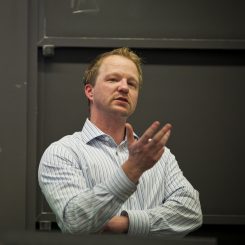CEEPR Working Paper
2025-14
Christopher R. Knittel, Juan Ramon L. Senga, and Shen Wang
Data centers are among the fastest-growing electricity consumers, with their energy demand projected to increase over the coming years. In the U.S., that projection is an increase of 7-12% by 2030. This surge is driven by advances in artificial intelligence and the prevalence of cloud computing, which poses challenges for grid reliability and decarbonization efforts. The additional load could put stress on the grid and increase the usage of existing thermal power plants, which may increase carbon emissions. For example, in PJM, the forecasted increase of 32 GW (20% increase) in summer peak load mostly comes from data centers and is equivalent to adding another mid-sized state’s demand to the system. However, opportunities exist to operate data centers more flexibly as demand response resources, potentially mitigating large load impacts. One of these strategies takes advantage of a latent demand response resource we call data center temporal flexibility—the ability of data centers to change its load profile by shifting workload across time.
However, it is unclear how this flexibility affects power system planning and operations. The ability to shift demand could significantly impact investment decisions, plant retirements, and operational strategies. This may alter the trajectory of capacity expansion and reliability planning for regional operators. Second, the potential grid benefits that flexible data centers bring are not yet understood for different levels of flexibility. While some portion of the data center load is flexible, the degree to which it can be shifted is constrained over time. Tasks cannot be postponed indefinitely, and certain tasks may not be shifted at all. Thus, understanding the combinations of flexibility levels (in terms of duration and shifting potential) that can lower cost and emissions is critical. Furthermore, the impact of data center flexibility on different regions may vary depending on the characteristics of the regional grid.
We use the GenX capacity expansion model (CEM) to answer these questions. We model combinations of scenarios that vary the shifting horizon—the time window in which loads can be shifted—from 1 to 24 hours, and the share of flexible workload—the fraction of total shiftable demand—from 1% to 100%.
Our findings show that data center temporal flexibility can significantly change a power system’s operations and generation mix. Higher flexibility levels enable net load shifting from peak to off-peak hours, flattening the net load profile. This reduces reliance on peaker or ramping plants and promotes more stable operation of base load generators. When renewables are sufficiently cost-competitive—as in Texas, where wind and solar are projected to supply 54% of generation—high levels of data center flexibility results in up to 40% lower CO2 emissions and accelerate retirements of coal and nuclear plants. This reverses in the Mid-Atlantic and WECC: renewable penetration is lower, coal units that survive retirements can run more uniformly, and system-wide emissions rise by as much as 3%, even though costs still fall.
We confirm this cost sensitivity in a counterfactual experiment that raises renewable investment and fixed O&M costs in Texas to 1.3 times baseline values. Renewable share collapses to 21%, coal plants remain on the system, and the emissions advantage of flexibility disappears—demonstrating that data center load shifting substitutes for baseload when clean energy is economical.
Across all regions and price scenarios, however, temporal flexibility always lowers total system costs—by up to 5% in Texas—while steering new investment toward renewables (wind in Texas, solar in WECC and the Mid-Atlantic) and crowding out battery storage. Flexible data center operations thus emerge as a robust, low-cost reliability resource whose climate value hinges on the underlying economics of clean power.

Figure 1. Cost and Emissions Reduction.
Top row (A, B, C): Heatmaps show the percentage reduction in total system cost from introducing flexible data centers, relative to a system without flexibility, across combinations of shifting horizon and share of flexible workload. Middle row (D, E, F): Heatmaps of percentage reduction in system CO2 emissions under the same flexibility configurations, relative to the no flexibility baseline. Bottom row (G, H, I): Heatmaps of percentage reduction of system CO2 emissions of a reference system with no data center flexibility and no data center load growth. Green (red) color indicates a decrease (increase) in CO2 emissions relative to the no growth scenario. The “no growth” baseline assumes data center load in 2030 maintains the same share of total system load as in 2022.
Note: Color scales vary across rows.





